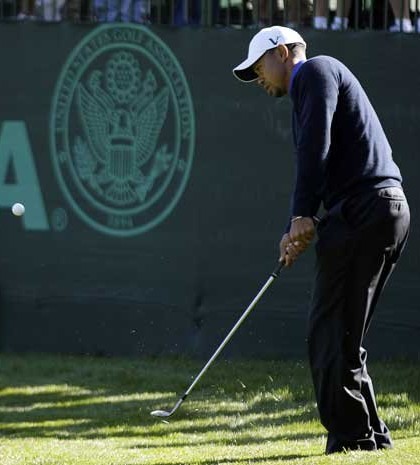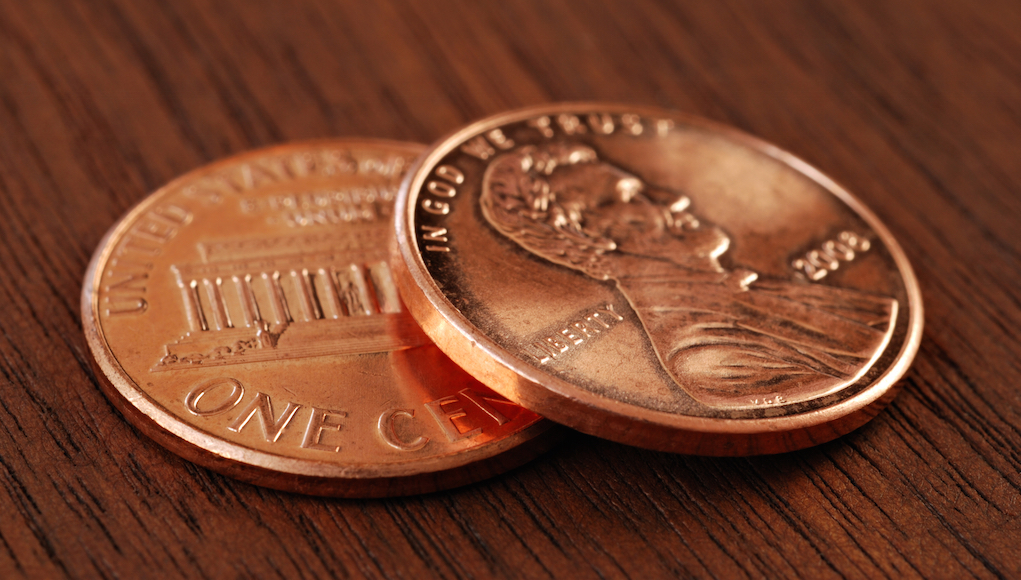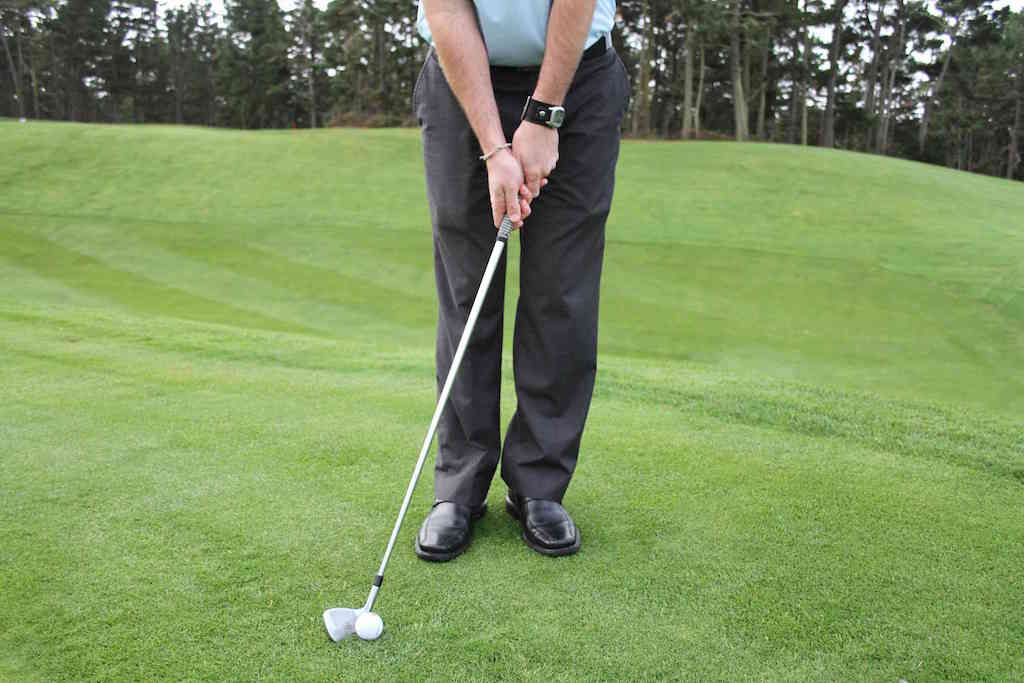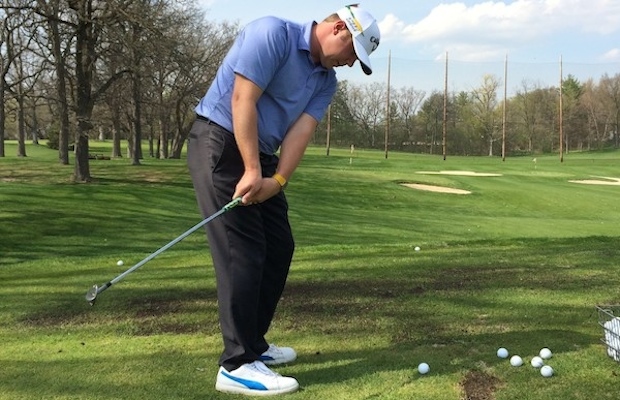Instruction
Short game: By air or by land?

When I’m working with students on their short games, I see too many players who are trying to play high shots around the greens. It’s a thing to behold when Phil or Tiger hoists a greenside shot straight up into the air, but I’ve found that most golfers benefit from the “land route.”
Generally speaking, there are two different kinds of shots golfers can play around the green, the chip and the pitch. Here’s an easy way to remember the difference between the two shots:
- A chip: a low shot that takes a low swing
- A pitch: a high shot that takes a high swing
If you elect to run the ball along the ground with a chip shot, you need to think of a short, low takeaway with little-to-no wrist break. If you elect to play a shot that flies higher with a pitch shot, you need to think of a short, higher takeaway with more wrists in the backswing. These are broad descriptions, but a lesson or two on technique will help you if you are struggling around the greens.
But what you probably want to know is when to play each shot. When should golfers put the ball in the air and when should they run it on the ground?
I teach this philosophy, and also used it successfully during my days as a competitive player:
When I miss the green, I PUTT whenever I can. I CHIP if I can’t putt and PITCH only when I must.
In golf, we are always trying to get the odds on our side. Because of the the swing involved, a chip is a much easier and much more predictable shot to than a pitch. It is a smaller swing with less wrist action, less body motion and less follow through. The good old “bump and run,” and even lower flying chip shot, is the real go-to guy under the heat. You should use it whenever you can.
You hit a bump-and-run shot by moving the ball back in your stance. You then take the club back low and keep the hands in front of the clubhead through impact. The ball comes off the club very low and runs on the green. Practice this shot every chance you get.
But some times you cannot run the ball onto the green. In any of the following situations, a pitch shot might be the only option:
- A shot over an obstacle (water, sand, or tall grass)
- A shot to a very eleveated green
- When the hole is located close to the side from where you’re playing your shot (no green to work with)
In all these situations, the golf ball has to go up in the air. Choose a lofted club, position the golf ball toward the center or slightly forward in your stance and swing the club more up and down. The golf ball will fly high and stop more quickly — because of trajectory not spin by the way. Most times, there is not enough speed in the swing to spin the ball, but trajectory is just as effective.
Another advantage of chipping over pitching is you can learn one basics swing and vary the club selection. You can take anything from a sand wedge to a 7 iron depending on how far you want the ball to run out. When pitching, you are pretty much limited to 55 degrees or more of loft on your club to get the desired trajectory. To hit different pitch shots, you have to vary the length and pace of the swing more than you do when chipping.
Another reason for not pitching the ball unless you have to is the unpredictability of the outcome. Remember, just because you choose a lofted club doesn’t mean you MUST pitch; short chips can and should be played with lofted clubs as well.
So think low to help your short game; chip more often when you miss a green and don’t try to play the heroic shot when a higher-perentage one will do. If you are 20 to 30 yards short of the green to a middle or back hole location, you DO NOT have to lob the ball all the way to the hole.
One more thing: I’m often asked, “How can I spin the ball and get it to check?”
Well, there are a lot of factors involved in getting that result: a good attack angle, a soft cover golf ball, perfectly clean grooves and usually a tight lie. The professionals you see on TV can hit this shot pretty much any time they want. But the average golfer does not always have all the criteria I listed. If you’re playing a distance ball off fairways with spotty lies (especially in the rough) and you have not cleaned your grooves in a few holes, forget about “checking it” But the good news is you don’t have to!
As always, feel free to send a swing video to my Facebook page and I will do my best to give you my feedback.
Click here for more discussion in the “Instruction & Academy” forum.
- LIKE2
- LEGIT0
- WOW0
- LOL0
- IDHT0
- FLOP0
- OB0
- SHANK0
Instruction
Clement: Laid-off or perfect fade? Across-the-line or perfect draw?

Some call the image on the left laid off, but if you are hitting a fade, this could be a perfect backswing for it! Same for across the line for a draw! Stop racking your brain with perceived mistakes and simply match backswing to shot shape!
- LIKE0
- LEGIT0
- WOW0
- LOL0
- IDHT0
- FLOP0
- OB0
- SHANK1
Instruction
The Wedge Guy: The easiest-to-learn golf basic

My golf learning began with this simple fact – if you don’t have a fundamentally sound hold on the golf club, it is practically impossible for your body to execute a fundamentally sound golf swing. I’m still a big believer that the golf swing is much easier to execute if you begin with the proper hold on the club.
As you might imagine, I come into contact with hundreds of golfers of all skill levels. And it is very rare to see a good player with a bad hold on the golf club. There are some exceptions, for sure, but they are very few and very far between, and they typically have beat so many balls with their poor grip that they’ve found a way to work around it.
The reality of biophysics is that the body moves only in certain ways – and the particulars of the way you hold the golf club can totally prevent a sound swing motion that allows the club to release properly through the impact zone. The wonderful thing is that anyone can learn how to put a fundamentally sound hold on the golf club, and you can practice it anywhere your hands are not otherwise engaged, like watching TV or just sitting and relaxing.
Whether you prefer an overlap, interlock or full-finger (not baseball!) grip on the club, the same fundamentals apply. Here are the major grip faults I see most often, in the order of the frequency:
Mis-aligned hands
By this I mean that the palms of the two hands are not parallel to each other. Too many golfers have a weak left hand and strong right, or vice versa. The easiest way to learn how to hold the club with your palms aligned properly is to grip a plain wooden ruler or yardstick. It forces the hands to align properly and shows you how that feels. If you grip and re-grip a yardstick several times, then grip a club, you’ll see that the learning curve is almost immediate.
The position of the grip in the upper/left hand
I also observe many golfers who have the butt of the grip too far into the heel pad of the upper hand (the left hand for right-handed players). It’s amazing how much easier it is to release the club through the ball if even 1/4-1/2″ of the butt is beyond the left heel pad. Try this yourself to see what I mean. Swing the club freely with just your left hand and notice the difference in its release from when you hold it at the end of the grip, versus gripping down even a half inch.
To help you really understand how this works, go to the range and hit shots with your five-iron gripped down a full inch to make the club the same length as your seven-iron. You will probably see an amazing shot shape difference, and likely not see as much distance loss as you would expect.
Too much lower (right) hand on the club
It seems like almost all golfers of 8-10 handicap or higher have the club too far into the palm of the lower hand, because that feels “good” if you are trying to control the path of the clubhead to the ball. But the golf swing is not an effort to hit at the ball – it is a swing of the club. The proper hold on the club has the grip underneath the pad at the base of the fingers. This will likely feel “weak” to you — like you cannot control the club like that. EXACTLY. You should not be trying to control the club with your lower/master hand.
Gripping too tightly
Nearly all golfers hold the club too tightly, which tenses up the forearms and prevents a proper release of the club through impact. In order for the club to move back and through properly, you must feel that the club is controlled by the last three fingers of the upper hand, and the middle two fingers of the lower hand. If you engage your thumbs and forefingers in “holding” the club, the result will almost always be a grip that is too tight. Try this for yourself. Hold the club in your upper hand only, and squeeze firmly with just the last three fingers, with the forefinger and thumb off the club entirely. You have good control, but your forearms are not tense. Then begin to squeeze down with your thumb and forefinger and observe the tensing of the entire forearm. This is the way we are made, so the key to preventing tenseness in the arms is to hold the club very lightly with the “pinchers” — the thumbs and forefingers.
So, those are what I believe are the four fundamentals of a good grip. Anyone can learn them in their home or office very quickly. There is no easier way to improve your ball striking consistency and add distance than giving more attention to the way you hold the golf club.
More from the Wedge Guy
- The Wedge Guy: Golf mastery begins with your wedge game
- The Wedge Guy: Why golf is 20 times harder than brain surgery
- The Wedge Guy: Musings on the golf ball rollback
- LIKE86
- LEGIT13
- WOW6
- LOL1
- IDHT0
- FLOP4
- OB1
- SHANK8
Instruction
Clement: Stop ripping off your swing with this drill!

Not the dreaded headcover under the armpit drill! As if your body is defective and can’t function by itself! Have you seen how incredible the human machine is with all the incredible feats of agility all kinds of athletes are accomplishing? You think your body is so defective (the good Lord is laughing his head off at you) that it needs a headcover tucked under the armpit so you can swing like T-Rex?
- LIKE0
- LEGIT2
- WOW2
- LOL0
- IDHT0
- FLOP0
- OB0
- SHANK2
-

 19th Hole2 weeks ago
19th Hole2 weeks agoDave Portnoy places monstrous outright bet for the 2024 Masters
-

 19th Hole3 days ago
19th Hole3 days agoJustin Thomas on the equipment choice of Scottie Scheffler that he thinks is ‘weird’
-

 19th Hole2 weeks ago
19th Hole2 weeks agoTiger Woods arrives at 2024 Masters equipped with a putter that may surprise you
-

 19th Hole3 days ago
19th Hole3 days ago‘Absolutely crazy’ – Major champ lays into Patrick Cantlay over his decision on final hole of RBC Heritage
-

 19th Hole2 weeks ago
19th Hole2 weeks agoTwo star names reportedly blanked Jon Rahm all week at the Masters
-

 19th Hole1 week ago
19th Hole1 week agoReport: LIV Golf identifies latest star name they hope to sign to breakaway tour
-

 19th Hole1 week ago
19th Hole1 week agoNeal Shipley presser ends in awkward fashion after reporter claims Tiger handed him note on 8th fairway
-

 19th Hole1 week ago
19th Hole1 week agoBrandel Chamblee has ‘no doubt’ who started the McIlroy/LIV rumor and why






















Sid N
May 9, 2013 at 1:13 am
As I was learning golf, I found that i got very comfortable hitting pitch shots to the green anywhere from 110 metres out. I would either hit a P, a Sand wedge or a 58 degree wedge. 50 – 60 metres out or nearer, it is always the 58 degree wedge. Depending on how far I am from the pin I would adjust how far left of the pin I aim and how much I open the club. Once I have decided on this I make sure that the ball is in the middle of my stance hands forward of the clubhead and I attack the pin almost all the time except on really hot dry days when the ball runs a lot and on those day I drop it a metre or two short of the green.
Using less clubs and not chipping with different lofts I find makes my thought processes simpler.
I only chip from under the trees with seven and sometimes use the P as almost a putter from the edge of the green.
I find this has made very consistent from 110 yards out.
Fadi
Nov 20, 2012 at 11:12 am
I never chip but I am going to try due to coming up short on all my pitchs lately. This seems like it is gonna help. At least I hope so. Ben Hogan did say he prefers a low runner to high floater.
Steven Mendelson
Oct 25, 2012 at 9:35 pm
Best thing I ever did was take lessons from Dennis. I finally learned to not break my wrists on chips and he added 30 yards to my drives. Thanks.
Vincent Dice
Oct 25, 2012 at 4:43 pm
Great article!
It’s so nice to see someone write about this. I argue with my golf partners all the time about this.
I’ve applied this philosophy for years and it’s saved many a Par for me and turned a sure-fire double into a bogey. For a golfer like me, that’s great! I keep it out of the air as much as possible near the green.